Is There a “Best” Kind of Reusable Bag?
With more and more councils, states and countries around the world introducing plastic bag bans, the conversation is finally moving towards reusable bag options. Not a moment too soon, either!
Yet as with all things, there’s plenty of different options out there, and the choice can be overwhelming.
Different people have different opinions about what’s best. Whether that’s upcycled or Fair Trade, recycled, organic or vegan, or what the energy footprint is, we all have different priorities in our quest to live a little lighter.
So no, I don”t think there’s one “best” option. But I do think there are lots of “good” and “better” options when it comes to ditching the single-use disposables with something a little more environmentally friendly.
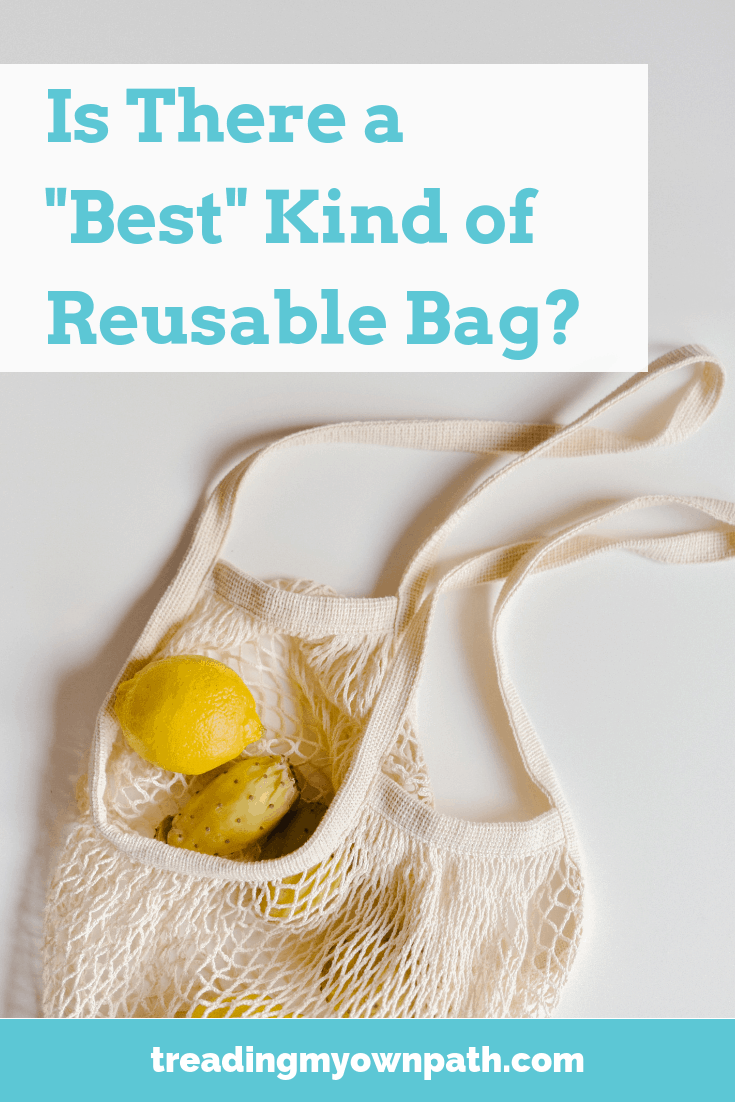
Reusable Shopping Bags: Zero Waste and Plastic-Free Alternatives to the Plastic Shopping Bag
I’ve highlighted some of my favourite options below, along with a couple more I think are best avoided.
Reusable Shopping Bags – Using What We Have
It goes without saying that the most environmentally friendly option is using the thing that we already have. Most of us have reusable shopping bags.
If we don’t, we’ve probably got old plastic bags from previous shopping trips. Don’t forget about backpacks, holdalls or other bags we might own.
Reusable shopping bags do not need to have been purpose-designed for that specific task. If it has handles and a compartment for shopping, it’s likely good enough. 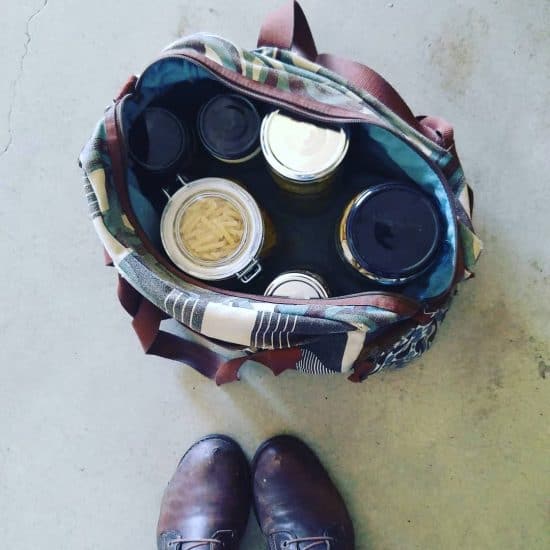
Reusable Shopping Bags – Borrowing (Boomerang Bags and Mors Bags)
You know those times when we find ourselves at the shops unexpectedly? Or we arrive with a list and then remember we need a few more things? Those times when we either don’t have a reusable bag, or don’t have enough?
Schemes like Boomerang Bags and Mors bags tackle exactly that problem. They recognise that most of us have reusable bags, but we also forget them sometimes. So they provide bags for us to borrow.

These schemes run on the power of community: to source second-hand fabric, sew into bags and leave in strategic locations where shoppers might need to borrow bags. The idea is that shoppers borrow bags, use them, and then return them ready for the next person.
No money is exchanged for the borrowing, although bags can sometimes be purchased to help cover expenses (such as screen-printing labels and providing cups of tea to volunteers).
(If sewing is your thing and you’ve been wondering how you can increase your impact, these groups are always on the look out for enthusiastic new volunteers!)
Reusable Shopping Bags – Upcycled Options
Shopping bags made out of repurposed fabric (think tablecloths, sheets, coffee sacks) is a great low-waste option that makes something good out of something that already exists.
Local markets are a great place to find creative craftspeople in your local area who make and sell reusable bags. If this isn’t an option for you, online marketplace Etsy is a great way to connect with sellers a little further afield. There’s plenty of options in terms of material, shape and size.
Reusable Shopping Bags – Recycled PET
Buying shopping bags made out of plastic can seem a little contradictory for anyone pursuing the plastic-free lifestyle. However, there’s a big difference between making bags with brand new virgin plastic and making bags with recycled PET plastic.
PET is the plastic that drinks bottles are made of. Even if we stopped making plastic drinks bottles tomorrow, there’s a heck of a lot of those plastic bottles already in existence in the world.
Recycling this plastic into a usable (and reusable) product seems a better solution that letting it languish in stockpiles all over the world. PET is also the most recyclable plastic there is.
From a lifecycle analysis point of view, these plastic bags have the lowest footprint of all reusable bags. They don’t demand new resources. Being plastic, they are also lightweight, hard-wearing and incredibly strong.
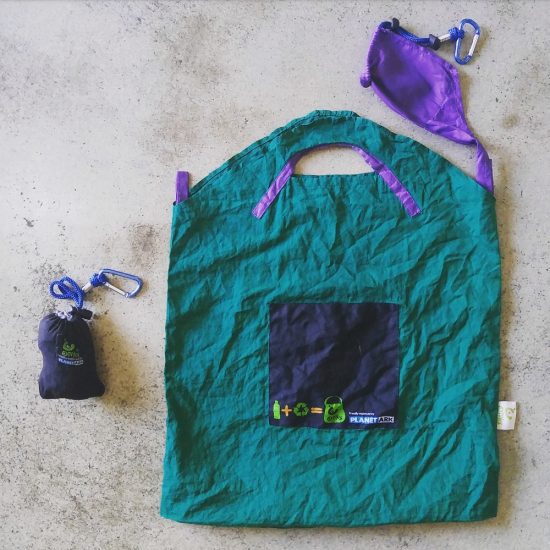
This (extremely well used and hence rather crumpled) recycled PET Onya bag is over 5 years old. It fits into a tiny stuff sack (you can see what it looks like packed down on the left – that’s a second bag).
From a waste perspective, yes they are still plastic. They can’t be composted at the end of their lives.
As much as I’m a fan of natural materials, I also know that our plastic legacy is something we need to deal with. Recycling PET plastic into reusable bags seems to be a good way to make good of a material already in existence.
In a perfect world we wouldn’t be having this conversation. But alas, the world isn’t perfect. The road to zero waste is full of compromise.
Reusable Shopping Bags – Cotton/Calico, Hemp and Jute
Natural fibres are a popular choice for reusable bags. They are typically hard-wearing and can be composted at the end of their useful lives. You’ll never see a reusable cotton shopping bag stuck up a tree as you might a plastic bag.
Of the three commonly used natural fibres, cotton is the most water- and chemical-intensive crop to grow. Organic cotton has a smaller eco footprint than regular cotton. For a lightweight, fold-up bag that fits in a handbag, cotton bags tend to be the most practical.
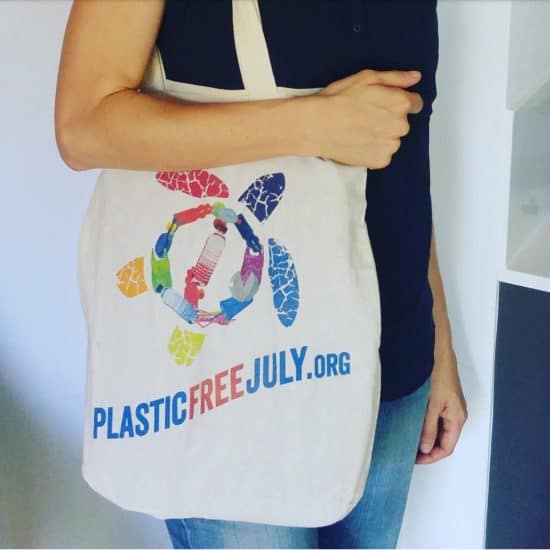
Jute and hemp are both considered more environmentally friendly than cotton, but the bags tend to be bulkier.
There’s a billion places to buy these kinds of bags. The supermarket would be my last choice. I’d much rather support a charity doing great work with my purchase. Or a small business. Or an independent chain. We vote with our dollars, so choose well.
(If you’d like to support independent eco-conscious businesses, here’s my list of worldwide online stores.)
Reusable Shopping Bags – The Ones to Avoid
With so many great options out there, there are a number of less-than-great options that are better avoided. Sometimes we end up with these things before we realise there are better options. Emergencies happen. If that’s you, don’t despair.
Use what you have, and next time, you can choose better.
Reusable Bags to Avoid – Thicker Plastic Bags
Some stores are replacing single-use plastic bags with reusable thicker plastic bags (usually polyethylene), often for a small charge.
These bags are made either partly or wholly of brand new, virgin plastic. They may contain some recycled material – if so, the bag should specify the amount.
These are heavier duty, but despite often being called “Bags for Life” they are estimated to be used an average of 5 times. Not single-use, but not much of an improvement. They are prone to splitting, and the handles also stretch when the contents are heavy.
These bags still present a litter problem when they inevitably end up in the environment.
Reusable Bags to Avoid – Non-Woven Plastic “Green” Bags
These bags are commonly sold in supermarkets and are called “green” bags more because they tend to be the colour green rather than because there is anything environmentally friendly about them. Although they appear to be made of fabric, they are actually made of plastic. Polypropylene (plastic number 5), to be specific.
They are much thicker than single-use plastic bags, and consequently need to be used many more times to be beneficial to the environment. In fact, a study suggested they need to be used 104 times to be environmentally positive. Truthfully, they tend to fall apart long before they are used that much. They are also bulky and cumbersome.
If you already have these bags, use them as long as you can. When they reach the end of their life, consider replacing with something better.
…
There’s plenty of reusable options when it comes to shopping bags, but the main consideration is whether it will work for you. There’s never one right choice. Sometimes, it’s different choices for different situations.
Regardless of material, the best reusable is always the one that actually gets reused.
Now I’d love to hear from you! What is your favourite type of reusable bag? Do you have a preference for different materials? Is there an product or brand not mentioned that you’d recommend? Anything else to add? Please share your thoughts in the comments below!
[leadpages_leadbox leadbox_id=140b48fc6639c5] [/leadpages_leadbox]
(Disclaimer – I’m an affiliate for Onya, which means if you click the link and choose to make a purchase, I may be compensated a small amount at no extra cost to you. I have been using their products since 2012: I’d only ever recommend something I have tried myself or that has been recommended to me by you, my readers. As always, my first suggestion is to use what you have or choose second-hand before buying anything new.)
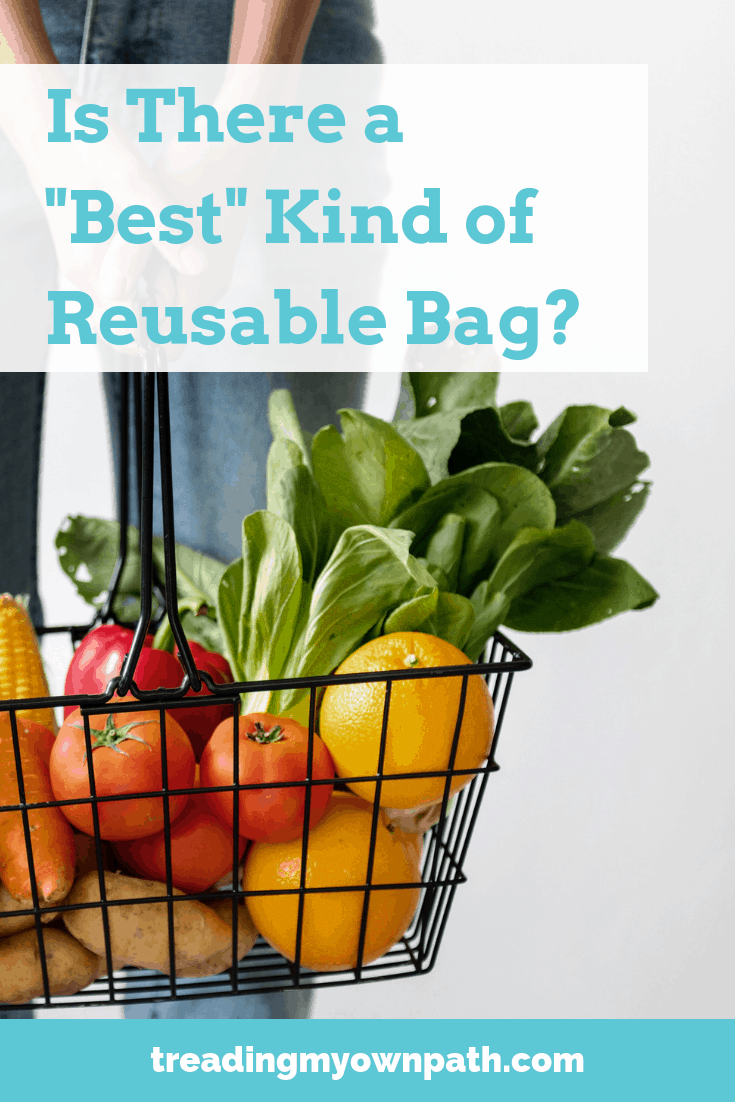

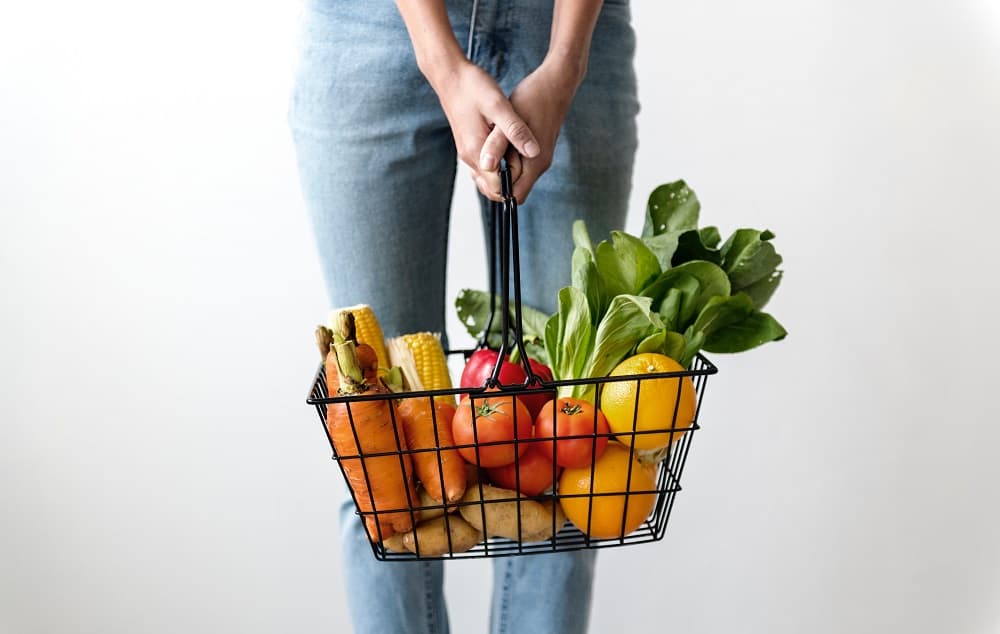




For a reusable bag I prefer a textile that can be washed for hygiene reasons.
I’ve been making morsbags for over 10 years.
We make them to give them away for free – they don’t have to be returned.
We make them with unwanted textiles and I use the old handcrank Singer machines This makes it as sustainable as I can make it – we’re repurposing the fabric, reusing the machines and not using any electric power (but this isn’t essential, you can use an electric machine too)
This all sounds a bit worthy. The truth is I’ve had such a lot of fun and good times from this project.
Not being tied to a power cable means I can take them out and about to festivals and get other people involved in making their own bag.
I’ve met so many lovely people this way and made some lifelong friends.
It’s such a positive thing.
It also makes you start thinking of ways to avoid other plastics in your life too.
Anyone can join in the project – the details about how to make the morsbags are online. There are instructions and a video.
You can make just 1 morsbag it you want – but it does get a bit addictive.
Thanks for sharing the details TC :) I used to work in an ethical office building (it housed a bunch of not-for-profits and community organisations) and we had Mors bags at the door for people to borrow and return when they went to town. I don’t know who made them, but it is such a great idea!
Really liked your thoughts about the hand-cranked machine too. I hadn’t given it much thought but you’re so right about it completely freeing up your movement to go to events etc! Love it!
I use ecosilk bags made of parachute silk and can also be rolled up and popped in a handbag. They last for years.
Thanks for sharing, Janet! I think I’ve heard of this before, but had forgotten about it so thank you for the reminder! :)
Baskets as much as possible for me. Two of mine are at least 20 years old. Calico and boomerang bags for back up. Worth considering shopping less…a little more often means your food is fresher and you can easily carry it in a couple of bags.
I didn’t even think of baskets Nirala – great point! There are some great 100% natural ones about the place – and of course I love that yours are 20 years old!
Great article! One of your best blogs yet!
Thanks Bob! Glad you enjoyed it!
I like baskets too but keep a string bag for impulse buys. I have rather a lot of those.
Ah string bags are another great one that I totally forgot about, Ann! (Baskets somehow slipped my mind also, as I mentioned in response to another comment.)
Don’t you just love how many brilliant options exist?!
I have a large-compartment woven straw basket that I bought a couple of years ago at an artisan fair. I love to use for quick shopping trips – all the merchants love it for its beauty and ease of packing up my purchases when I pay. I also feel comfortable gathering my soon-to-be purchases as I roam the store. This is by far my go-to shopping bag. I also have fabric bags I bring with me when doing a larger shopping trip.
~TMH~
Another basket fan, TMH! I love baskets, I don’t actually own any but I think they look so beautiful as well as being both functional and practical. Thanks for the suggestion!
I have used the ‘Green Bags’ for well over 10 years and only ever thrown one out. As for the ‘Blue’ cooler bags, only one of those also went out of service as a bag because the zipper broke. But I snipped off the handles turned it inside out and voila – one non specific purchased steering wheel cover for when the car is parked on a summers day. Very effective.
I bought my supermarket ‘green bags’ so long ago that i cant remember too! I would be much more discerning nowadays with my purchase of bags but like lindsay said, it’s better to use what we have first. I credit the longevity of my bags to the fact that i always store them flat and take a few seconds of extra care when packing them away.
The idea for the reuse of the cooler bag is one i will definitely use phil! Thanks!
Hi Emily, great thoughts and what I touched on above – how things last is a direct result of whether/how/if we look after them well! Glad to hear you’ve been able to make yours last :)
I’m glad to hear that you’ve been able to make yours last, Phil! That’s great. I wonder if people tend to overfill them and they’s why they split or stretch. How we treat things has a direct impact how long they last, of course!
And love the tip about repurposing the blue bag (for any reader who thinks this doesn’t make sense, the blue cooler bags have a shiny foil lining, so turn the bag inside out and there’s a reflective surface!)
The ‘green’ bags from supermarkets that are actually plastic can be recycled with other plastic (chips, bread etc type of bags).
Hi Liz, yes, the green bags are made of polypropylene (PP, plastic #5) which can be put in the collection bins operated by RedCycle and other places that collect soft plastic. But the plastic they are made of is polypropylene, which is a lower grade and lesser value plastic than many other types (PET, HDPE and LDPE are all more valuable and therefore more recyclable and more recycled plastics).
Polypropylene is also not thermostable and will break down in heat, so isn’t really a plastic that lasts.
And when it is recycled it is usually mixed with new virgin plastic (often 1 part recycled plastic to 3 parts new virgin plastic).
On top of that, these green bags tend to be made of virgin plastic, not recycled plastic. So when compared to the other options out there, they are a much less environmentally sound choice. With so many other options to choose from, these would be my last choice. But of course, if we have them already, taking them to be recycled limits some of the strain on the environment and our planet’s resources :)
I have many reusable bags but the most used ones are two fabric ones that fit into my purse (they ball up inside my hand). They are very lightweight but they are very very strong. I’m not sure what type of fabric they are but it’s similar to an umbrella (looking that up it’s a nylon). I have had them for over 9 years where as other bags I have had I have had to sew back up due to holes in the bottom.
In Canada, we have to pay at most grocery stores 5 cents a bag for plastic bags and they are usually those thicker ones (that you mentioned would have to be used 104 times) but they break or have holes after a couple of uses. There still are less than half the people that use reusable bags when I’m there despite having the pay for bags for about 4-5 years.
Hi Heather, your lightweight bags sound like the same idea as the Onya ones I have – strong and scrunch up very small. I think there’s definitely something to be said for bags that fit inside purses and handbags – that’s what stops us forgetting them, after all!
When the bag ban comes in here I think most supermarkets will begin selling thicker plastic bags. The green bags they already sell cost $1, I think, and the thicker plastic “bags for life” I’m not sure about cost, but I expect will be less than $1. It will be interesting to see how bag use changes. I’m positive it will go down, but it will be interesting to see how much!
I’ve been using envirosax for years and years. They are unfortunately plastic, but roll up nice and small so I’m rarely without at least one. I haven’t discarded one yet. For big supermarket shops I do, alas, have my ancient fleet of “green” bags. But the other thing I use a LOT is my wheely jeep – which also, alas, has plastic components. But it’s good for large volumes. I am diligently trying to use what I already have, but will definitely be more discerning when acquiring new bags in the future – although that is still some time off. I love your blog – it keeps me thinking and striving to do better.
Hi Ellen, just had a quick google of Envirosax and they sound like the Onya ones I have, except Onya use recycled PET and I couldn’t see that on the other website. Rolling up nice and small is key to not forgetting, in my view! :)
Love how you call your “green” bags your fleet! Yep, use up what you have ;) I’ve noticed that whenever I have something that I want to use up and replace with something better, it always seems to mean that the original lasts forever! Which is a good thing, really! Hope your fleet keeps going strong for a while more! ;)
I was given an Envirosax for Christmas 2009 and have used it for pretty much every shopping trip since. When my mum gave me another one a few years ago, I was disappointed because I didn’t think I really needed another one, but I make use of it as well, and will for many years to come.
The best reusable bag I have been given is one made of repurposed curtain fabric, modelled on the pattern of the ‘green bag’ (the lady who made it for me was inspired to make it when I told her about the Boomerang Bags that I make) – it is very strong and robust and great for shopping at the bulk store with my containers.
I also have a cotton Go Vita shopping bag, but it doesn’t handle as much weight as the Envirosax. My oldest bag of all is a Penguin canvas bag that I was given in 2003; it has been travelling with me and I continue to use it regularly.
As a cyclist, I used to have a bike with a detachable basket – I’d just carry that around the shop and pop it back on the bike to go home. Of course, there’s only so much you can carry on a bike.
Just another comment on the green polypropylene bags that supermarkets are keen on promoting, I have read that they are virtually indestructible and if put into landfill they won’t ever break down. The only way they can be broken down is by being incinerated.
I have noticed that a lot of department stores including shoe stores are keen on providing you with one of these indestructible bags, complete with their store logo emblazoned all over it to carry home your purchases.
Hi Christine, that’s not entirely true. For a start, polypropylene is actually not that stable and degrades in sunlight – definitely destructable. It can also be recycled, but requires new plastic to be mixed in with it, so not the best but still better than landfill and much better than incineration.
Yes, these bags are used a lot as a promotional “gift”. No thanks! ;)
Great summary, I have a collection of the “green” bags that are falling apart, so I’ve been looking out for cotton/calico options, which are so much nice and easy to wash etc.
Those dastardly green bags! I hope your new fleet of natural ones last much longer! (And yes, machine washable is sooooo important!)
So glad you mentioned”washable” as its very important to keep your shopping bags clean. It’s surprising how many germs can be on them, especially ones used for meat.
Terrific article, very informative and well written. I am addicted to composting at home and have found a new compostable carry bag made by BioBag that is stronger than traditional compostable bags and breaks down within 5 weeks in compost. My worms find it yummy and I like the idea of making fertiliser for my garden from my carry bags. They’re also handy to carry a whole pile of compostables down to my bin including toilet rolls, paper, cardboard, banana peels, etc as my compost caddy is too small for everything I put into it daily :-)
Wonderful reusable bags!!! I like it.
Thank you for this – I appreciate how you also included the bags to avoid at the end of this list.
Lindsay, great article. please add that the polypropylene ‘green’ or whatever colour bags can be recycled thru Coles soft plastic program (I have visited the Replas factory and and this is correct, strange tho it may seem).
re boomerang bags, there are more doona covers tossed out than we will ever finish sewing into bags; I love it because it upcycles the fabric.
Hi Geraldine! I didn’t talk about the recyclablility of bags at the end of their lives simply because everyone has access to different facilities and it van be a little confusing. Of course, when disposing of anything it’s best to find out if it is recycable. And yes, those green ploypropylene bags are currently recycled by Replas, who have bins at some Coles stores in Austrailia :)
You’re so right about tossed out fabric! :/
It is great to read such informative blogs. Reusable bags are truly fashionable bags. Many different design cotton reusable bags are available in Market.
Love this idea!!! What a great way to recycle
Nice Post. Thanks for sharing it………….:) :)
I really liked the concept of boomerang bags! They’re so convenient and handy when you’ve forgotten to bring along your reusable bag. Also, as mentioned in your post, jute bags are bulkier than plastic and cotton but look more appealing and have a rustic touch to them. Moreover, there’s a perfect design for every occasion – shopping, gifting, giveaways.
I use a large round open African basket made in Ghana which means I can see what’s in there easily and fruit and veg don’t get squashed. Most shops have paper mushroom bags that I also use for loose onions, snow peas etc which I pop into my basket. I use the empty mushroom bags as bin liners in bathrooms and in the car to collect tissues, parking tickets etc. Shopping for bulkier heavy items such as glass bottles of juice I simply put them into the shopping trolley, load them into my car boot where I keep a storage box (protects the glass and I can carry it into the house). I use paper potato sacks ( get these at fruit & veg shops as well as Farmer Jacks) as kitchen bin liners, I wrap kitchen scraps that can’t go into the compost in newspaper which I tape closed with paper masking tape before putting into council bin. This keeps my bin clean too. I do have several fabric bags that fold into themselves that I keep in my car for unplanned shopping trips. The most difficult things I find is packaging, what do I use as deodorant to replace my essential oil product which is locally made but Is in a plastic roll on?
Leah
Great blog on jute bags now days they are very useful instead of plastic bags to avoid global warming . keep it up.
Today everyone thought of having a zero waste environment especially schools and through this article, lots of teachers encourage kids to go for zero waste supplies.
Thank you and do share such type of contents.
very interesting article. Is Canvas bags okay?
I must admit that I have ‘met’ some really bad canvas bags. You know when you wash it and the colour bleeds and the bag shrinks…. and the bag in question is meant to last for years… I had to throw it out. I like the slim, thin linen or cotton ones. Especially linen as it doesn’t stain easily. Linen for everything, really. Anyone with me on linen?
Hugs to all!
I like your post it is very nice. I am a bag manufacturer so this post is useful for me.
i have one calico bag my sister gave me they are very strong and easy to wash
i started using jute lunch bags for my whole family they are strong and long lasting its been 9 months already they are still new
Very Helpful and Informative post.
Nice Article with useful information about Eco friendly reusable bags .
Always No for plastic bags for save Environment
https://www.cpc-vietnam.com/
You can share this post on twitter. Just go here https://soclikes.com and buy twitter re-tweets
I think it is most advisable to use quality fabric bags that can be washed many times and used for several years. The biggest evil is low-quality promo bags that have almost the same long carbon footprint but quickly deteriorate.
It is good idea to use such bags.
Thank you for this useful post. Now such topic is popular on tiktok. You can make video about your bags. But first check this article https://www.digitalconnectmag.com/why-purchasing-likes-for-tiktok-could-be-good-for-your-video-creator-career/ maybe it will help you.
Nice post!
Thank you! I think more people should read this post about reusable bags.
I’m sure people on Instagram would love a post like this! If you’d like to get more likes on it, visit https://krootez.com
Hmm , very interesting thoughts! I think In order for more interested people to read your thoughts, you should post it on Instagram, and use the services of https://viplikes.net/ to quickly increase the amount of followers.
Thanks for sharing this.
Gee , extremely fascinating considerations! I figure for additional intrigued individuals to peruse your considerations, https://penzu.com/public/ad4ed975 thank you